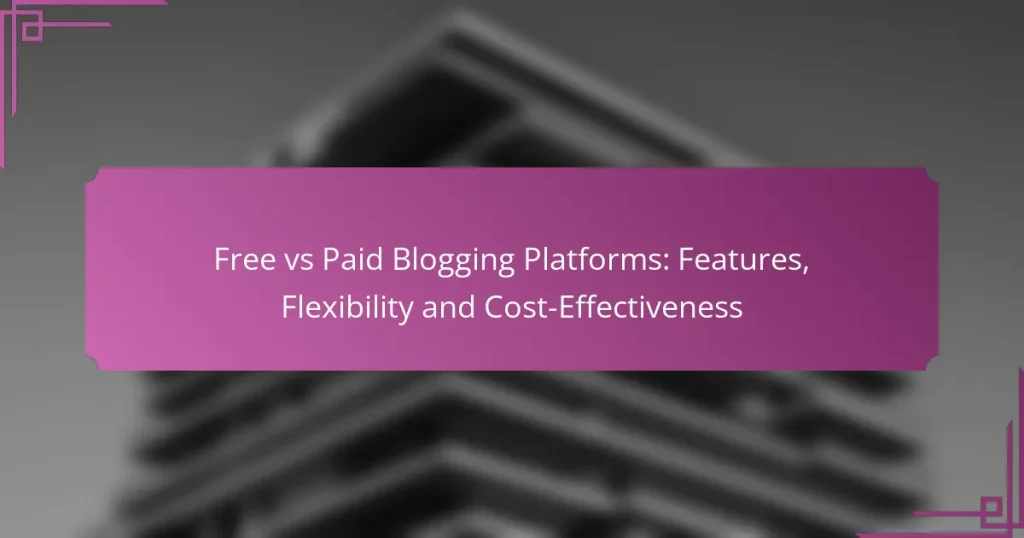When choosing between free and paid blogging platforms, it’s essential to consider features, flexibility, and cost-effectiveness. Free platforms like WordPress.com and Blogger provide basic functionalities without upfront costs, but they often lack customization and advanced tools. In contrast, paid options such as WordPress.org and Squarespace offer enhanced features, better SEO capabilities, and dedicated support, making them ideal for serious bloggers looking to invest in their online presence.
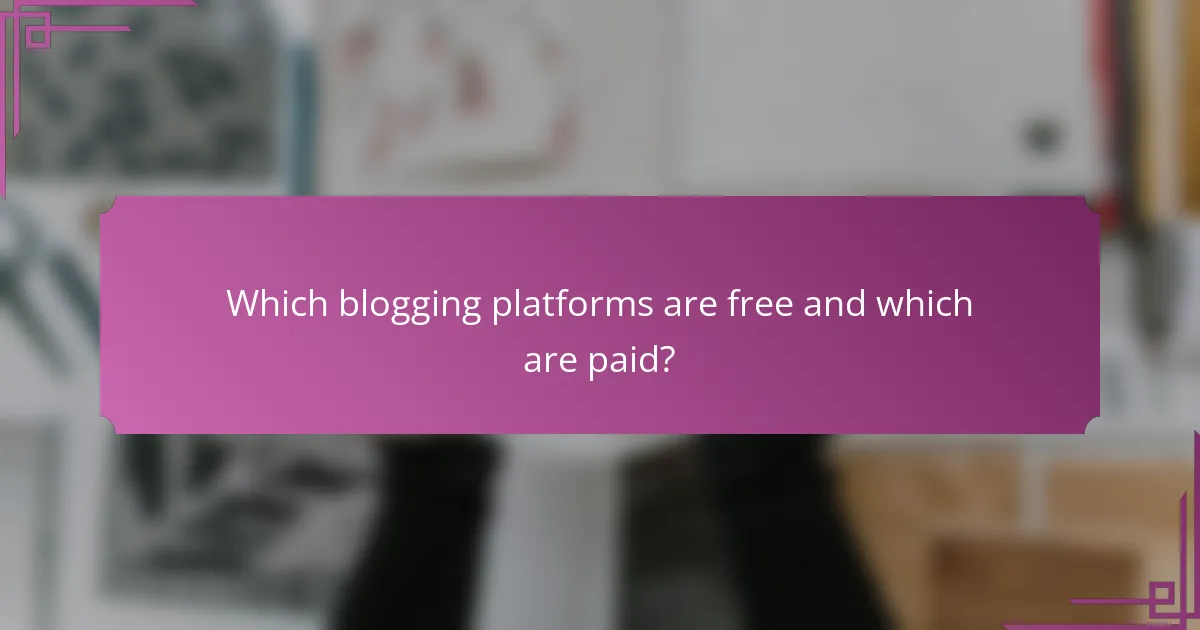
Which blogging platforms are free and which are paid?
Free blogging platforms include options like WordPress.com and Blogger, while paid platforms consist of WordPress.org and Squarespace. The choice between them often hinges on features, flexibility, and cost-effectiveness.
Free platforms: WordPress.com, Blogger
WordPress.com and Blogger are popular free blogging platforms that allow users to create and publish content without any upfront costs. These platforms typically offer basic features, including customizable templates and limited storage, making them suitable for hobbyists or casual bloggers.
However, free platforms often come with restrictions, such as limited monetization options and the presence of ads. Users may also face constraints on design flexibility and functionality, which can hinder growth as the blog evolves.
Paid platforms: WordPress.org, Squarespace
Paid platforms like WordPress.org and Squarespace provide more robust features and greater control over your blog. WordPress.org requires users to purchase hosting and a domain, offering extensive customization options and the ability to install plugins for enhanced functionality.
Squarespace, on the other hand, is a subscription-based service that combines hosting and design tools in one package. It is known for its visually appealing templates and user-friendly interface, making it ideal for those who prioritize aesthetics and ease of use.
Comparison of features
When comparing free and paid blogging platforms, consider key features such as customization, storage, and monetization options. Free platforms generally offer limited customization and storage, while paid platforms provide extensive flexibility and the ability to monetize through ads or e-commerce.
For example, WordPress.org allows for complete control over your site with thousands of plugins and themes, while Squarespace offers beautiful design templates that are easy to set up. Ultimately, the choice will depend on your specific needs, goals, and budget.
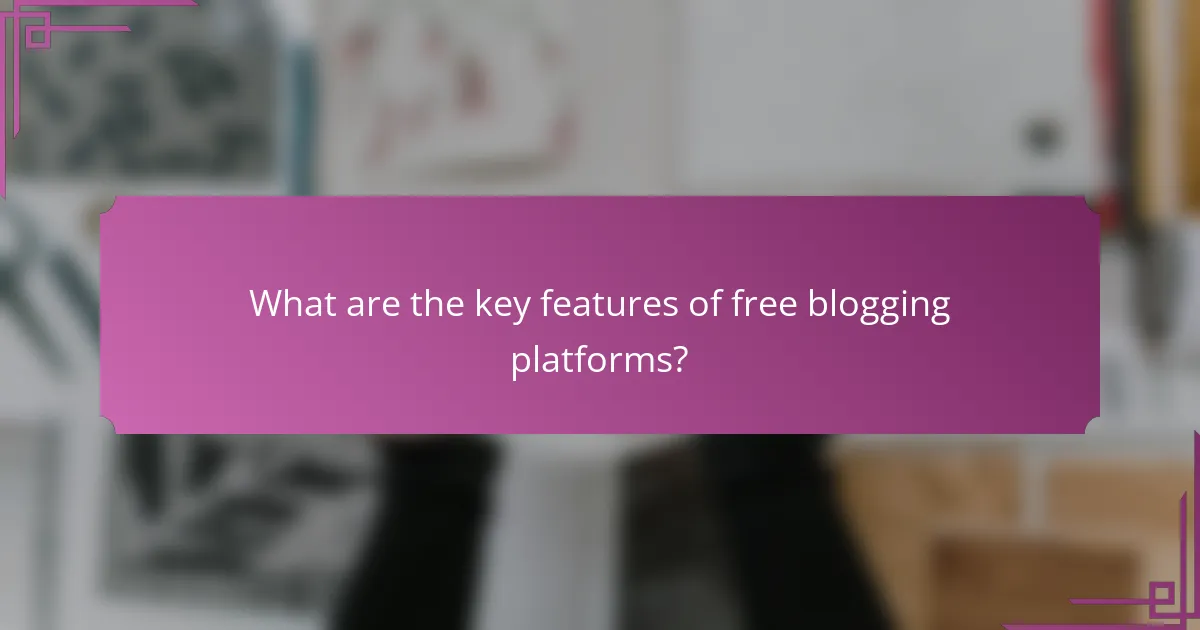
What are the key features of free blogging platforms?
Free blogging platforms typically offer essential features that allow users to create and publish content without upfront costs. However, these platforms often come with limitations in customization, analytics, and overall flexibility compared to their paid counterparts.
User-friendly interfaces
Free blogging platforms are designed with user-friendly interfaces that make it easy for beginners to start blogging. Most platforms provide intuitive drag-and-drop editors, allowing users to create posts without needing technical skills or coding knowledge.
For example, platforms like WordPress.com and Blogger offer straightforward navigation and templates that simplify the setup process. This accessibility can be a significant advantage for those looking to share their thoughts quickly and efficiently.
Limited customization options
While free blogging platforms provide basic templates, customization options are often limited. Users may find themselves restricted to a set number of themes and layouts, which can hinder their ability to create a unique brand identity.
Many free platforms do not allow users to modify HTML or CSS, meaning advanced customization is off the table. This limitation can be frustrating for bloggers who want to tailor their site to reflect their personal style or specific audience needs.
Basic analytics tools
Free blogging platforms usually offer basic analytics tools that provide insights into visitor traffic and engagement. These tools can help users understand their audience and improve content strategies, but the data may be limited compared to paid services.
For instance, while you might see the number of views and unique visitors, detailed metrics like user demographics or behavior patterns may not be available. Bloggers should consider whether these basic analytics meet their needs or if they will require more advanced tracking in the future.
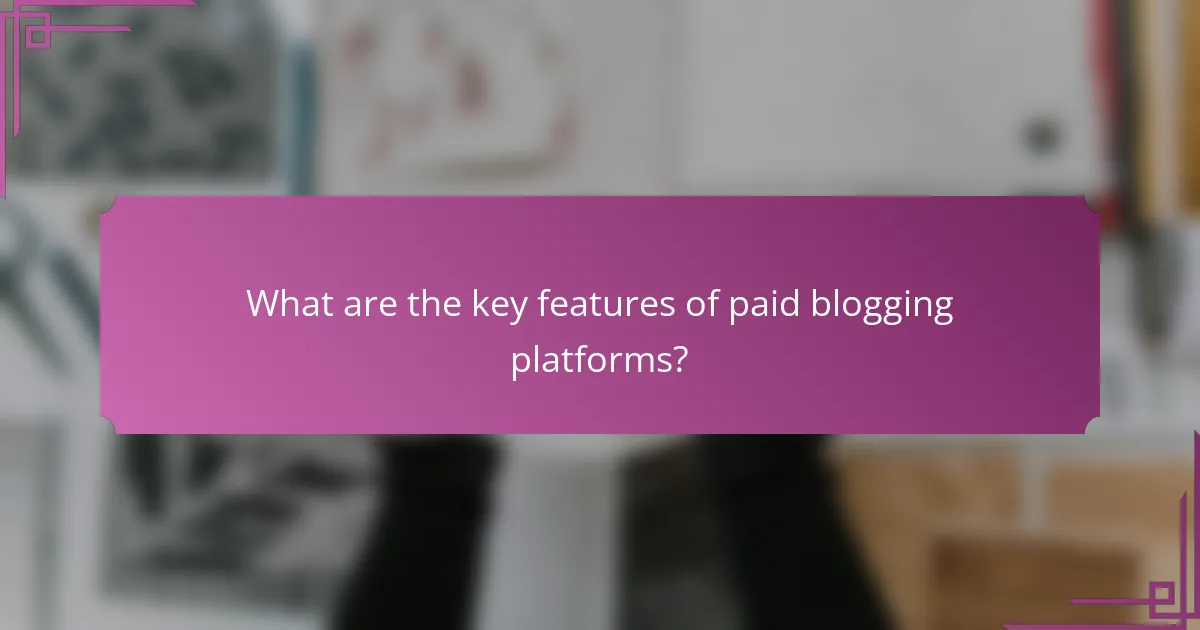
What are the key features of paid blogging platforms?
Paid blogging platforms offer a range of features that enhance user experience, customization, and overall functionality compared to free options. These platforms typically provide advanced tools for customization, improved SEO capabilities, and dedicated support, making them a worthwhile investment for serious bloggers.
Advanced customization capabilities
Paid blogging platforms allow users to customize their sites extensively, offering a variety of themes and design options. Users can often modify HTML and CSS, enabling them to create a unique look that aligns with their brand identity.
Many paid services also provide plugins and widgets that enhance functionality, such as social media integration and e-commerce capabilities. This level of customization is crucial for bloggers looking to stand out in a crowded market.
Enhanced SEO tools
Paid platforms typically come equipped with advanced SEO tools that help improve site visibility on search engines. Features may include customizable meta tags, XML sitemaps, and built-in analytics to track performance.
These tools are essential for bloggers aiming to drive organic traffic, as they allow for better keyword optimization and content structuring. Investing in a paid platform can lead to higher search rankings and increased readership over time.
Dedicated customer support
With paid blogging platforms, users often benefit from dedicated customer support, which can be a significant advantage. This support may include live chat, email assistance, and comprehensive knowledge bases to help troubleshoot issues quickly.
Having access to reliable support ensures that bloggers can resolve technical problems efficiently, minimizing downtime and allowing them to focus on content creation rather than site maintenance.

How do free and paid blogging platforms compare in flexibility?
Free blogging platforms often come with significant limitations in flexibility compared to paid options. While free platforms may be suitable for casual bloggers, paid platforms provide extensive customization and control over the blog’s design and functionality.
Customization limitations in free platforms
Free blogging platforms typically restrict users to predefined templates and limited design options. Users may find it challenging to implement unique branding or advanced features, which can hinder the blog’s overall appeal and functionality.
For instance, many free platforms do not allow custom domain names, forcing users to settle for a subdomain. Additionally, monetization options are often limited, making it difficult to generate revenue from the blog.
Full control in paid platforms
Paid blogging platforms offer users complete control over their site’s design, functionality, and monetization strategies. Users can select from a wide range of customizable themes and plugins, allowing for a tailored blogging experience that meets specific needs.
For example, with a paid platform, you can use a custom domain, implement various monetization methods such as affiliate marketing, and access advanced analytics tools. This level of flexibility can significantly enhance the blog’s potential for growth and revenue generation.
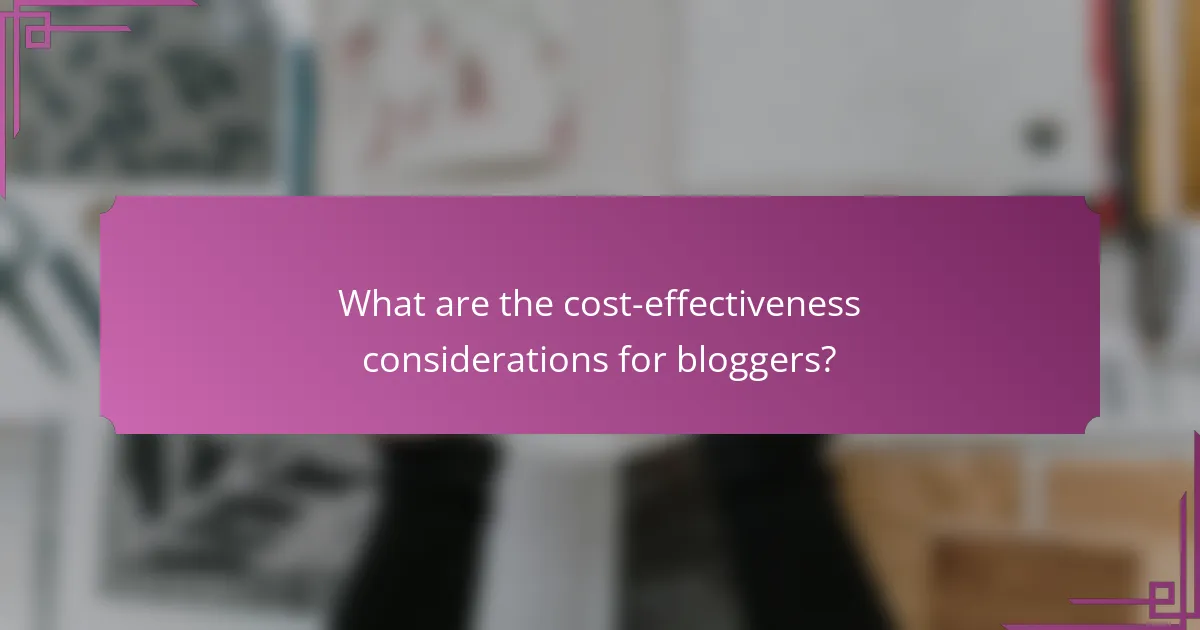
What are the cost-effectiveness considerations for bloggers?
Cost-effectiveness for bloggers involves evaluating both initial expenses and long-term value when choosing between free and paid platforms. Understanding these factors helps in making informed decisions that align with budget and blogging goals.
Initial costs of paid platforms
Paid blogging platforms typically require upfront investment, which can range from a few dollars per month to several hundred annually, depending on features. Common costs include domain registration, hosting fees, and premium themes or plugins. For instance, a basic hosting plan might start around $5 to $15 per month, while a custom domain can cost about $10 to $20 per year.
When considering initial costs, assess what features are essential for your blog. Some platforms offer bundled services that may save money in the long run, while others may charge extra for essential functionalities.
Long-term value of paid platforms
Long-term value encompasses not just ongoing costs but also the potential for growth and monetization. Paid platforms often provide better support, enhanced security, and more customization options, which can lead to increased traffic and revenue over time. Investing in a paid platform can yield returns through advertising, affiliate marketing, or selling products.
Consider the scalability of the platform. A solution that starts at a low cost but charges significantly more as your blog grows may not be the best choice. Evaluate the total cost of ownership over several years to ensure it aligns with your blogging ambitions.
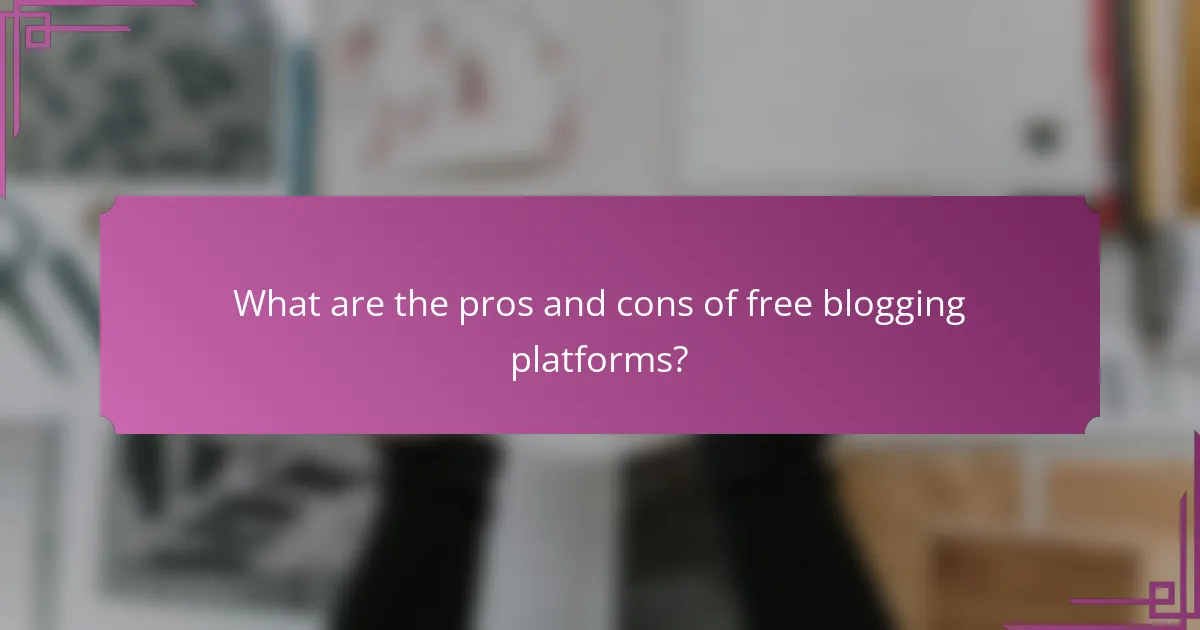
What are the pros and cons of free blogging platforms?
Free blogging platforms offer an accessible way to start a blog without any financial commitment, but they come with limitations that can affect your blogging experience and growth potential.
No financial investment required
One of the main advantages of free blogging platforms is that they require no upfront costs. Users can create a blog and start publishing content immediately, making it ideal for beginners or those testing the waters of blogging.
Many popular platforms, such as WordPress.com and Blogger, allow users to set up a blog in minutes without any fees. This accessibility encourages experimentation and creativity without the pressure of financial investment.
Limited monetization options
While free blogging platforms are cost-effective, they often restrict monetization options. Users may find it challenging to integrate ads or affiliate marketing, limiting their ability to generate income from their blogs.
For instance, platforms like Wix and Weebly may impose restrictions on ad placements or charge fees for premium features that enable monetization. This can be a significant drawback for bloggers looking to turn their passion into a profitable venture.
